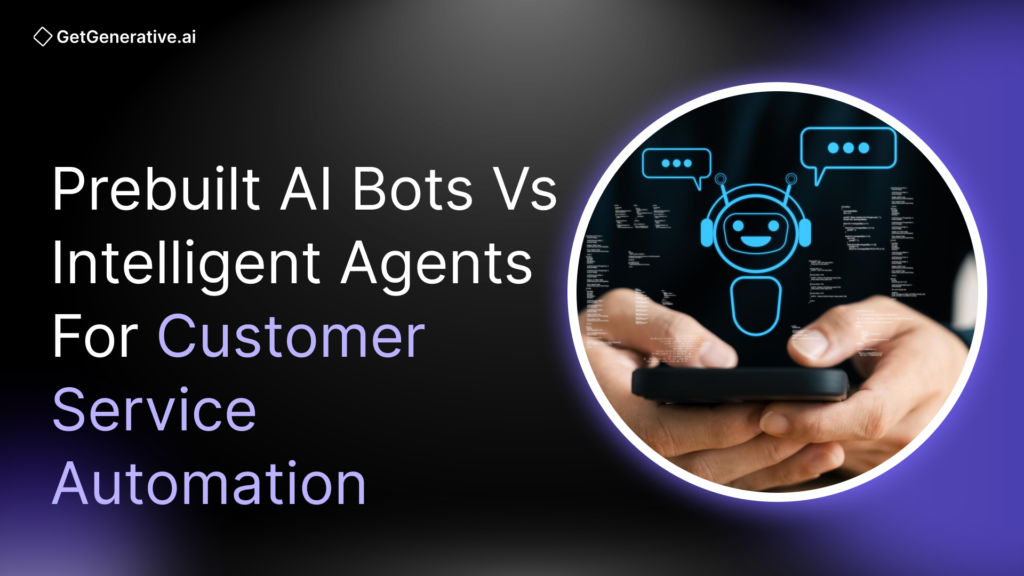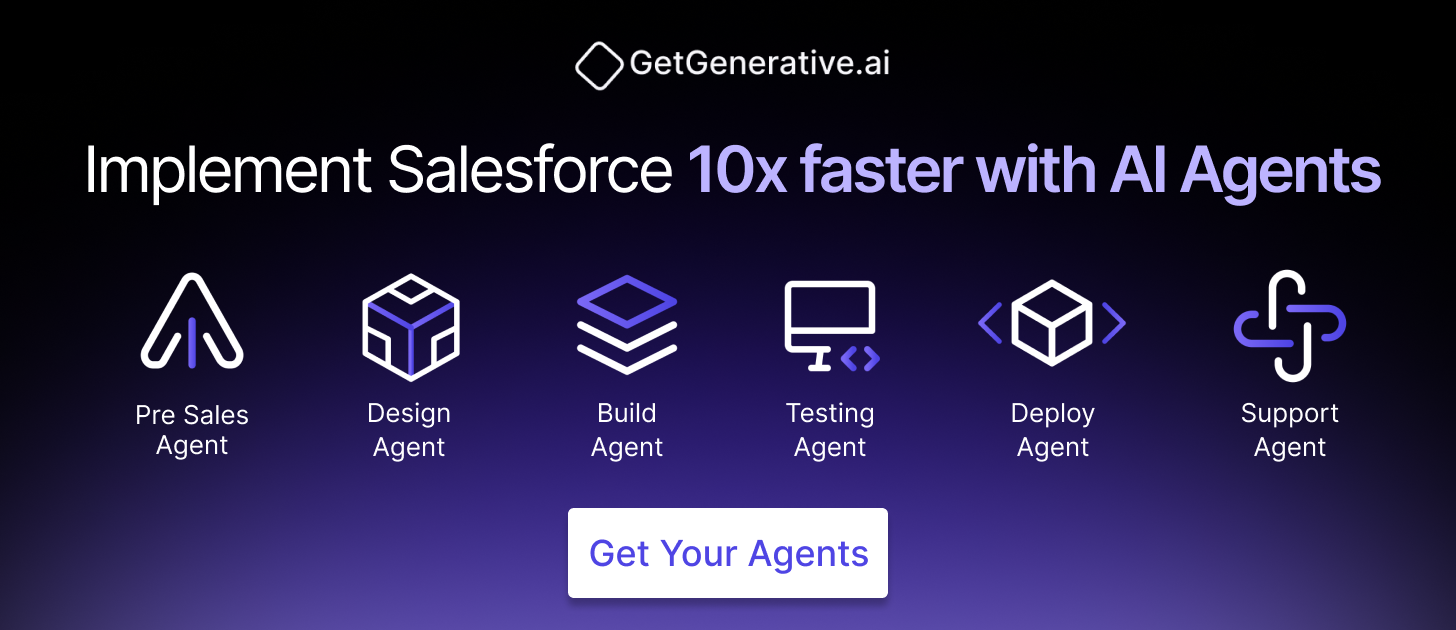Prebuilt AI Bots vs Intelligent Agents for Customer Service Automation
According to Zendesk’s 2024 CX Trends Report, 90% of consumers expect real-time responses, and 76% prefer to resolve issues via self-service when possible. For Salesforce professionals, this has intensified the need for scalable support solutions that go beyond traditional call centers.
Enter: prebuilt AI bots and intelligent AI agents — two dominant approaches to customer service automation. While both promise 24/7 availability and faster response times, they differ substantially in architecture, flexibility, cost, and customer experience.
This blog offers a comprehensive, research-backed comparison to help decision-makers choose the right solution for their Salesforce environment or evaluate third-party tools like Intercom Fin or IBM watsonx Assistant. Let’s get started!
Traditional Prebuilt AI Bots: Fast, Simple, and Reliable
What Are Prebuilt AI Bots?
Prebuilt AI bots are conversational assistants designed for rule-based automation. These bots operate using decision trees, keyword triggers, and static content pulled from a knowledge base. Popular examples include:
- Salesforce Einstein Bots (integrated with Service Cloud)
- Zendesk Answer Bot
- Microsoft Power Virtual Agents
- IBM Watson Assistant (legacy rule-based mode)
These bots are quick to configure, require little or no coding, and handle common service tasks like order status, password resets, return policies, and FAQs.
Key Capabilities and Benefits
- Rapid Deployment: Launchable within days using drag-and-drop tools or templates.
- CRM Integration: In Salesforce, Einstein Bots connect with Service Cloud, Omni-Channel Routing, and CRM records.
- Predictable Costs: Typically range between $5,000–$25,000, depending on complexity and customization.
- Consistent Customer Experience: Delivers templated responses with minimal error.
- Deflection at Scale: Zendesk reports that its Answer Bot deflected 10% of Dollar Shave Club’s total ticket volume, averaging 4,500 tickets/month.
“Einstein Bots are revolutionizing service by handling routine queries, allowing agents to tackle complex issues.”
— Bill Patterson, Salesforce EVP & GM, C360 Applications
Use Case Example
Dollar Shave Club implemented Zendesk’s Answer Bot to resolve FAQs like delivery times and billing queries. The bot resolved thousands of monthly tickets autonomously, improving agent focus and reducing first-response times.
Limitations
Despite their efficiency, prebuilt bots are fundamentally limited by design:
- Static Flows: Cannot adapt to unanticipated queries or complex logic.
- No Reasoning: Fail when conversations deviate from scripts.
- Low Personalization: Cannot dynamically tailor responses based on customer history or tone.
A Salesforce bot is essentially a vending machine — it works brilliantly when users follow the script, but struggles when they don’t.
Also Read – AI Chatbots vs AI Agents: What’s the Real Difference for Salesforce Users?
What Are Intelligent AI Agents?
Intelligent agents are LLM-powered autonomous assistants designed to reason, act, and adapt dynamically in customer interactions. Unlike prebuilt bots, they don’t rely on predefined paths but instead understand natural language, evaluate context, and take actions like updating records, issuing refunds, or escalating cases.
Notable intelligent agents include:
- Salesforce Einstein Service Agent (Agentforce)
- Intercom Fin AI Agent
- IBM watsonx Assistant (generative mode)
Core Advantages
- Generative AI: Composes brand-aligned responses on the fly using LLMs like Einstein GPT.
- Contextual Reasoning: Understands complex requests, recalls past interactions, and identifies intent.
- Dynamic Execution: Performs backend tasks—like opening support tickets or triggering workflows—autonomously.
- Multi-Modal Engagement: Functions across chat, email, voice, and mobile apps.
- Grounded Responses: Tied to CRM, knowledge base, and enterprise databases to prevent hallucinations.
“The agent does a better job of understanding intent and matching it to the right answers.”
— Abhi Rathna, Director of Product, Agentforce Platform, Salesforce
Use Case Example
Lightspeed Commerce deployed Intercom’s Fin AI Agent and reported:
- 65% resolution rate on all incoming support tickets
- 31% increase in daily tickets resolved per agent when using Fin as a copilot
These outcomes translated into major efficiency gains and higher CSAT scores.
Challenges
- Higher Complexity: Requires robust governance, training data, and system integration.
- Risk of Hallucinations: Without guardrails like Salesforce’s Einstein Trust Layer, LLMs may generate inaccurate or non-compliant responses.
- Cost Considerations: Usage-based pricing (e.g., token-based billing) adds operational expense.
Salesforce’s Agentforce Advantage
Salesforce’s Einstein Service Agent (Agentforce) stands out for its:
- Native Data Cloud Integration: Full visibility into customer history and transactions.
- Low-Code Setup: Launch via flows, templates, and AI model configuration—no need for deep ML expertise.
- Secure by Design: Applies enterprise-grade guardrails via the Einstein Trust Layer.
Platform Comparison: Salesforce vs. Zendesk vs. Intercom vs. IBM
Platform | Prebuilt Bot | Intelligent Agent | CRM Integration | Unique Strengths |
Salesforce | Einstein Bot | Agentforce | Native (C360) | Deep CRM grounding, Omni-Channel flow, Einstein GPT |
Zendesk | Answer Bot | AI Suggestions | Indirect via API | Easy KB matching, good ticketing integration |
Intercom | Fin Bot | Fin AI Agent | Moderate (via APIs) | Strong generative features, Fin Copilot for agents |
IBM Watson | Watson Assistant | watsonx Assistant | External CRM | Secure RAG pipelines, compliance-ready for regulated industries |
Comparative Analysis: When to Use Bots vs. Agents
Understanding the distinction between prebuilt bots and intelligent agents isn’t just academic—it’s strategic. Below is a breakdown across critical enterprise decision criteria:
Factor | Prebuilt AI Bots | Intelligent AI Agents |
Use Case Scope | FAQs, policy info, simple tasks | Complex, multi-turn queries; dynamic workflows |
Technology | Rule-based, keyword-triggered | LLM-powered, generative, retrieval-augmented |
Setup Time | Rapid (days to weeks) | Moderate (weeks to months depending on use case) |
Integration Depth | Shallow to moderate | Deep (requires CRM grounding, data orchestration) |
Cost Profile | Predictable, low-to-mid | Higher upfront + usage-based costs (e.g. token use) |
Scalability | Horizontal scaling, static logic | Learns and improves with usage, adaptive logic |
CX Personalization | Limited, template-based | High personalization, empathy, history-aware |
Compliance Risk | Low (scripted flows) | Medium to high (requires trust layers & governance) |
Also Read – Salesforce AI Cloud vs Third-Party AI Integrations: Pros and Cons
Cost vs. Value
According to Gartner, LLM-based agents can cost up to 4x more than traditional bots—but deliver 2–5x the ROI when deployed strategically. Consider the following real-world benchmarks:
- Dollar Shave Club:
Answer Bot deflected 10% of total ticket volume (4,500/month)
➜ Lowered agent load without affecting CSAT. - Lightspeed + Intercom Fin:
65% AI resolution rate + 31% more tickets per agent
➜ Dramatically improved agent productivity and self-service capacity. - Camping World + IBM Watson:
33% increase in agent efficiency + 40% more customer engagement
➜ Reduced wait times to 33 seconds using generative AI and automation.
These examples confirm that intelligent agents generate measurable impact, not just in volume deflection but in time saved per agent, CSAT boosts, and operational efficiency.
Integration, Trust, and Governance
Integration Depth
Salesforce has a native edge here. Both Einstein Bots and Agentforce live inside the Salesforce 360 Platform:
- Data Cloud ensures a unified customer profile
- Omni-Channel Routing supports hybrid flows (bot → agent → human)
- Trust Layer filters unsafe outputs, masks sensitive fields, and ensures compliance
Conversely, external platforms (e.g., Intercom, IBM Watson) require API-based integration with Salesforce CRM. This is feasible, but adds setup and maintenance work.
Governance and Security
For intelligent agents in particular, guardrails are non-negotiable. Salesforce offers:
- Einstein Trust Layer: Redacts sensitive data, enforces prompt safety, applies model constraints
- Auditability: Tracks how generative content is created and used
- Admin Controls: Determine when and where agents can act autonomously
IBM’s watsonx and other enterprise tools offer similar controls, especially suited for regulated industries like healthcare or finance. If you’re in a GDPR/HIPAA-compliant environment, these security features should drive your vendor selection.
Final Thoughts
If your organization handles predictable, high-volume support cases, start with prebuilt AI bots to optimize costs and accelerate support responsiveness.
If you aim to deliver highly personalized, autonomous service experiences, then intelligent agents—especially within Salesforce’s ecosystem (Agentforce + Einstein GPT + Omni-Channel)—are your future.
If you’re exploring how to move beyond scripted chatbots and bring real intelligence into your Salesforce service operations, GetGenerative.ai offers a workspace where AI agents help you handle everything, from early planning to go-live.
No scattered tools, no guesswork. Just a practical way to manage the entire lifecycle with more clarity and less effort.
Book a demo now to see how it works!




